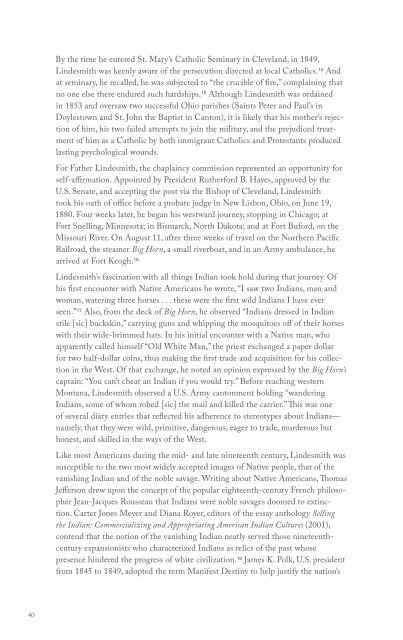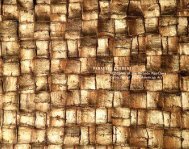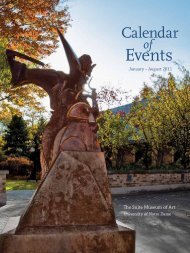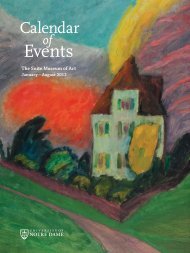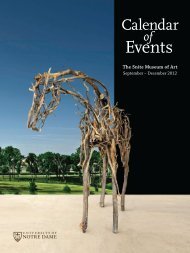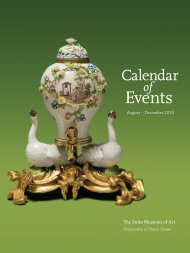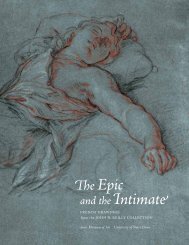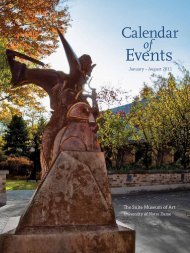HISTORY INTO ART AND ANTHROPOLOGY - Snite Museum of Art ...
HISTORY INTO ART AND ANTHROPOLOGY - Snite Museum of Art ...
HISTORY INTO ART AND ANTHROPOLOGY - Snite Museum of Art ...
You also want an ePaper? Increase the reach of your titles
YUMPU automatically turns print PDFs into web optimized ePapers that Google loves.
By the time he entered St. Mary’s Catholic Seminary in Cleveland, in 1849,<br />
Lindesmith was keenly aware <strong>of</strong> the persecution directed at local Catholics. 14 And<br />
at seminary, he recalled, he was subjected to “the crucible <strong>of</strong> fire,” complaining that<br />
no one else there endured such hardships. 15 Although Lindesmith was ordained<br />
in 1853 and oversaw two successful Ohio parishes (Saints Peter and Paul’s in<br />
Doylestown and St. John the Baptist in Canton), it is likely that his mother’s rejection<br />
<strong>of</strong> him, his two failed attempts to join the military, and the prejudiced treatment<br />
<strong>of</strong> him as a Catholic by both immigrant Catholics and Protestants produced<br />
lasting psychological wounds.<br />
For Father Lindesmith, the chaplaincy commission represented an opportunity for<br />
self-affirmation. Appointed by President Rutherford B. Hayes, approved by the<br />
U.S. Senate, and accepting the post via the Bishop <strong>of</strong> Cleveland, Lindesmith<br />
took his oath <strong>of</strong> <strong>of</strong>fice before a probate judge in New Lisbon, Ohio, on June 19,<br />
1880. Four weeks later, he began his westward journey, stopping in Chicago; at<br />
Fort Snelling, Minnesota; in Bismarck, North Dakota; and at Fort Buford, on the<br />
Missouri River. On August 11, after three weeks <strong>of</strong> travel on the Northern Pacific<br />
Railroad, the steamer Big Horn, a small riverboat, and in an Army ambulance, he<br />
arrived at Fort Keogh. 16<br />
Lindesmith’s fascination with all things Indian took hold during that journey. Of<br />
his first encounter with Native Americans he wrote, “I saw two Indians, man and<br />
woman, watering three horses . . . these were the first wild Indians I have ever<br />
seen.” 17 Also, from the deck <strong>of</strong> Big Horn, he observed “Indians dressed in Indian<br />
stile [sic] buckskin,” carrying guns and whipping the mosquitoes <strong>of</strong>f <strong>of</strong> their horses<br />
with their wide-brimmed hats. In his initial encounter with a Native man, who<br />
apparently called himself “Old White Man,” the priest exchanged a paper dollar<br />
for two half-dollar coins, thus making the first trade and acquisition for his collection<br />
in the West. Of that exchange, he noted an opinion expressed by the Big Horn’s<br />
captain: “You can’t cheat an Indian if you would try.” Before reaching western<br />
Montana, Lindesmith observed a U.S. Army cantonment holding “wandering<br />
Indians, some <strong>of</strong> whom robed [sic] the mail and killed the carrier.” This was one<br />
<strong>of</strong> several diary entries that reflected his adherence to stereotypes about Indians—<br />
namely, that they were wild, primitive, dangerous, eager to trade, murderous but<br />
honest, and skilled in the ways <strong>of</strong> the West.<br />
Like most Americans during the mid- and late nineteenth century, Lindesmith was<br />
susceptible to the two most widely accepted images <strong>of</strong> Native people, that <strong>of</strong> the<br />
vanishing Indian and <strong>of</strong> the noble savage. Writing about Native Americans, Thomas<br />
Jefferson drew upon the concept <strong>of</strong> the popular eighteenth-century French philosopher<br />
Jean-Jacques Rousseau that Indians were noble savages doomed to extinction.<br />
Carter Jones Meyer and Diana Royer, editors <strong>of</strong> the essay anthology Selling<br />
the Indian: Commercializing and Appropriating American Indian Cultures (2001),<br />
contend that the notion <strong>of</strong> the vanishing Indian neatly served those nineteenthcentury<br />
expansionists who characterized Indians as relics <strong>of</strong> the past whose<br />
presence hindered the progress <strong>of</strong> white civilization. 18 James K. Polk, U.S. president<br />
from 1845 to 1849, adopted the term Manifest Destiny to help justify the nation’s<br />
westward expansion. Meyer and Royer suggest that it was John Louis O’Sullivan, a<br />
political journalist, who first told white Americans it was their manifest destiny to<br />
overtake the lands American Indians “let lie fallow.” 19<br />
The concepts <strong>of</strong> the vanishing Indian and Manifest Destiny pr<strong>of</strong>oundly influenced<br />
common views <strong>of</strong> Indians, views Lindesmith wholeheartedly embraced. His biographer,<br />
Carlos Davila, suggests that Lindesmith’s perception <strong>of</strong> Indians as dangerous,<br />
primitive, and uncivilized stemmed in part from personal experience. According to<br />
Davila, Lindesmith recalled the fear his Ohio community felt during the Seminole<br />
rebellions in Florida <strong>of</strong> the 1830s. He also noted in his diaries that he had been<br />
chided as a young boy by relatives and peers who called him an “Indian” for not<br />
wearing a hat and for hunting with a bow and arrow. 20<br />
Not surprisingly, Lindesmith’s collection cataloguing notes reflect prevailing<br />
notions. For instance, in describing the cultural context <strong>of</strong> the Battle <strong>of</strong> the Little<br />
Big Horn, he wrote:<br />
The [Sioux] refused the right to building the Northern Pacific Railroad<br />
through Montana. They refused to sell any <strong>of</strong> their land. They refused to go<br />
to farming or stock raising. They refused to give up their savage life. They<br />
refused to send their children to school. They refused to receive missionaries.<br />
They refused to live on a reservation, where missionaries and good people<br />
would build churches for them, and schoolhouses for their children. . . . They<br />
refused everything that belongs to a civilized Christian life. They would do<br />
nothing but continue their heathen savage life. 21<br />
This passage not only demonstrates his belief that Indians were uncivilized, and<br />
therefore unworthy <strong>of</strong> the land they occupied, but also illuminates a stereotypical<br />
view that came to dominate his attitudes about collecting their cultural materials.<br />
For Lindesmith, Native people’s refusal to adopt or conform to a “civilized<br />
Christian life” marked them as primitive. 22 His notes accompanying the small piece<br />
<strong>of</strong> a shirt he acquired that had been worn by the slain Crow warrior Sword Bearer<br />
(fig. 8) clearly reflect this: “[Sword Bearer] prophesized . . . that with his wand he<br />
could make the soldier’s bullets fall <strong>of</strong>f him like small hail”; in reality, the warrior<br />
fell dead after being shot once. 23<br />
Reasoning that Native Americans were simply primitives on the verge <strong>of</strong> extinction,<br />
Lindesmith projected onto their material culture a singular historical value.<br />
By perceiving the Indian as a symbol <strong>of</strong> history and casting himself as a rescuer <strong>of</strong><br />
that history, he absolved himself <strong>of</strong> whatever moral hesitation he otherwise might<br />
have felt about misappropriation. Indian bones were more than human remains for<br />
Lindesmith; they were highly prized relics, as he made clear in this note accompanying<br />
a skull he acquired:<br />
On August 1, 1882: Girard Whistler son <strong>of</strong> Leut. Col J. N. S. Whistler<br />
found this Indian skull under a tree on the north-side <strong>of</strong> the Yellowstone<br />
in one <strong>of</strong> the Cooleys, where it had been placed as a burial on the tree, but<br />
fell down. He presented it to me. I am indeed very thankful to him, as I<br />
[consider it] quite a relic. 24<br />
40 41


